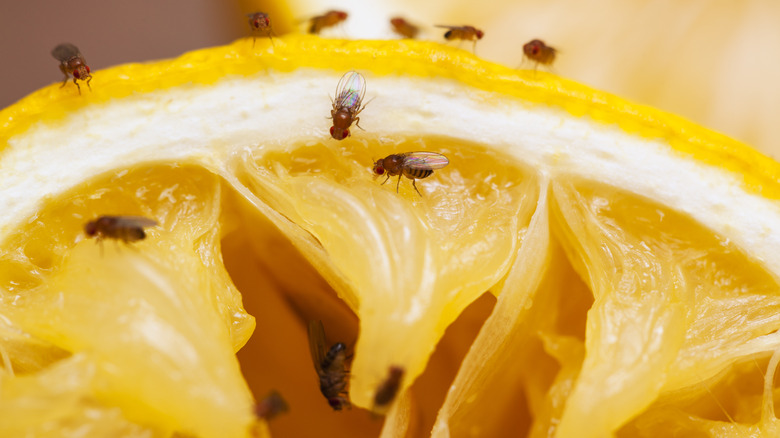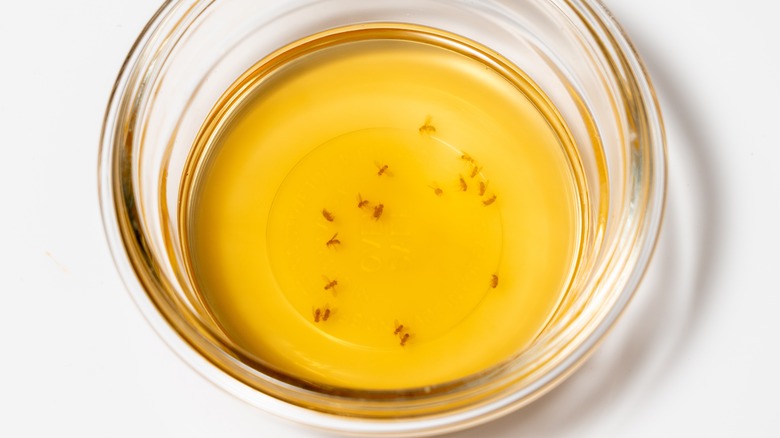Vinegar Vs Fly Traps: Which Should You Use To Get Rid Of These Tiny Pests?
We may receive a commission on purchases made from links.
Once fruit flies become a problem in our homes, it can appear impossible to get rid of them, with one or two always seeming to linger behind no matter what we do. Not only do these tiny flies, no larger than 4 millimeters, manage to drive us crazy, but they can spread bacteria throughout our kitchens. One fruit fly can rapidly descend into hundreds as females can lay up to 400 eggs each, which hatch in as little as 12 hours. Fortunately for us, we can set numerous traps and remedies to help eliminate the issue in tandem with deep cleaning and other preventive measures. But that poses the question: do home DIYs with vinegar work best, or should you rely on store-bought fly traps?
Vinegar has been a long-known hack to draw in and kill off fruit flies, the smell being prominent and alluring to the insects even if it can be a bit overwhelming for us. This is a great trick for those on a budget and looking for a quick trap to set, but it can often be an eyesore and will likely need to be changed out frequently. While store-bought fly traps are more expensive, and there is an overwhelming amount to choose from, they can last much longer and often come in desirable designs that will flow better with your kitchen's feng shui. Before you decide which route is best for your situation, take a deep dive into each solution and consider all angles.
How does vinegar trap fruit flies?
Fruit flies are drawn to sweet smells and fermenting liquids or garbage, and the scent that vinegar gives off has fermentation in spades. If you choose to use apple cider vinegar as opposed to typical white vinegar, you'll add the benefit of a sweeter smell and thus find better results. But both forms of vinegar will produce an effective outcome nonetheless. Once the fruit flies fly into the vinegar, they become disoriented and cannot find an escape easily, causing them to drown.
The great thing about vinegar traps is that vinegar is a relatively cheap house staple, and you likely already have everything needed to DIY this at home. You can set these up in many ways, one of the most common being using a glass jar and Saran wrap. Pour a couple of ounces of vinegar into the jar, cover and seal it with plastic wrap, and poke holes into the top. This trap may require trial and error as you must ensure the holes aren't so small the flies can't enter and not too big to where they can easily escape. A few more methods include creating a funnel with paper or a plastic bottle to place into the jar and adding a few drops of dish soap to make the flies sink quickly. The downside to vinegar remedies is they tend to be eye sore, the smell can permeate the room, and they must be changed frequently to wield the best success.
Using fly traps for fruit fly problems
One of the most compelling things about store-bought fly traps is how many different kinds there are. Amazon has numerous fly traps, from outlet plug-ins and countertop lures that mimic fruit to sticky pads and hanging strips. These traps can cost as low as $6 or up to $20. While these aren't as cheap as vinegar DIYs, you can browse first-hand reviews on whether certain traps worked for other customers. You're also paying more for a premade trap that's more aesthetically pleasing in design and smell. Having a jar of vinegar on the counter with bugs visibly floating around while the pungent smell filters through the air may not be the most appealing.
Store-bought traps are specifically made with fruit flies in mind, so where it may take a while to get your homemade trap to the perfect place, a fly trap will have already been constructed to the ideal standards. Some fly traps can even last well over a month before needing replacing. However, that doesn't necessarily mean it's the better option, as vinegar is nontoxic to pets or people. However, sometimes chemicals are added to store-bought products, and we don't always have the comfort of knowing everything we're breathing in. Overall, vinegar is an excellent solution if you want an affordable remedy that is eco-friendly, easy, and quick to assemble. Fly traps, on the other hand, will provide prettier and more convenient designs and last longer.

